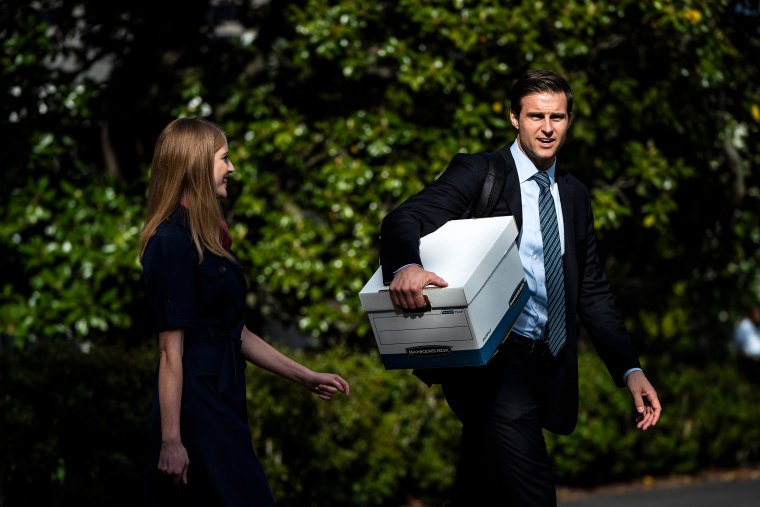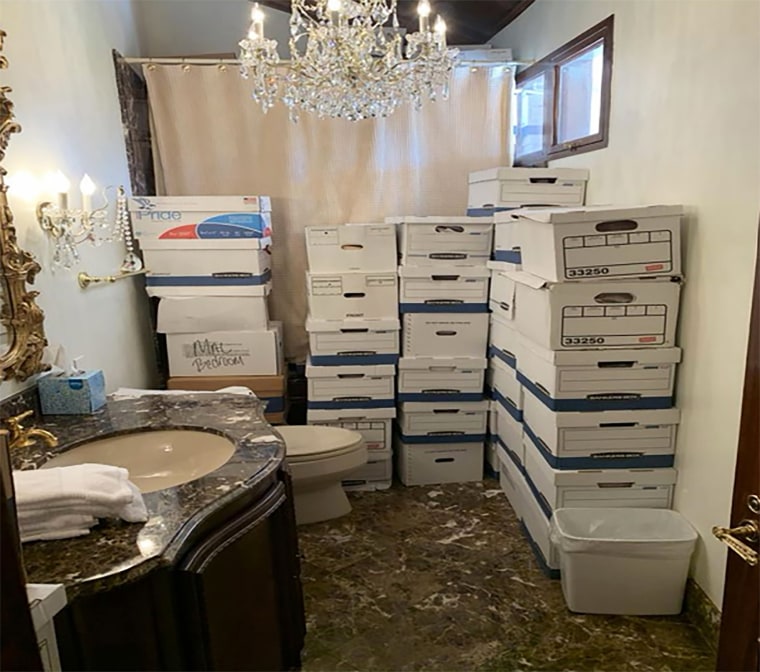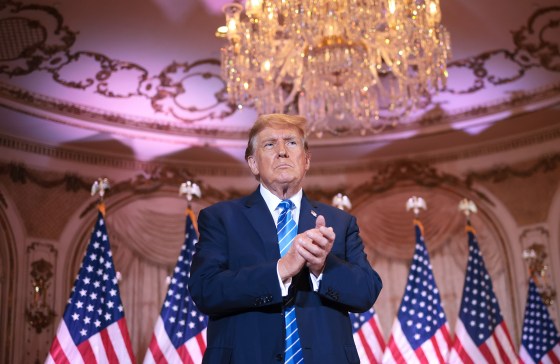This story is adapted from the forthcoming book by Leonnig and Davis, “Injustice: How Politics and Fear Vanquished America’s Justice Department,” which will be published Nov. 4 by Penguin Press.
Around 4 p.m. on Aug. 8, 2022, a team of FBI agents finished searching then-former President Donald Trump’s social club in a surprise raid and drove off in vans loaded with boxes that few expected would carry such extraordinarily sensitive cargo.
In a hastily convened conference call that evening, Assistant Attorney General Matt Olsen listened as his investigators described the hundreds of pages of top-secret records they found, some containing gravely serious material. Several detailed covert government operations and U.S. spying powers could get American operatives killed if the information fell into the wrong hands. Instead of the documents being kept under lock and key in a government safe, agents found them spilling out of boxes in Trump’s personal office, his residence and even a bathroom shower.
Olsen turned to his top Justice Department expert on the mishandling of classified records, Julie Edelstein, to ask what they should do next. She delivered a startling assessment.
“If it was anybody else, we would arrest him tomorrow,” Edelstein said.
Knowingly taking classified documents outside of a secure government facility was a crime, plain and simple, she explained. Trying to conceal them after receiving a May subpoena to return all classified records, as Trump had, made the crime far worse, she argued.
But Olsen’s team knew that with Trump, all bets were off. The Justice Department would invariably treat the former president more gingerly.
“If it was anybody else, we would arrest him tomorrow.”
Julie edelstein, ex-justice department official, on donald trump.
Trump has said recently that the search at Mar-a-Lago violated his civil rights and that he is considering authorizing the Justice Department to pay him $230 million in damages. But these new revelations from an unprecedented probe run counter to Trump’s insistence that he was mistreated and that he engaged in no criminal wrongdoing in withholding top-secret documents at his private social club.
In the aftermath of the 2022 search, Trump would erroneously claim the classified documents investigation was based on manufactured evidence and driven by a Democratic administration hell-bent on prosecuting him to hurt his chances of winning re-election in 2024.
A year after the 2022 search, after Special Counsel Jack Smith took over the case, a grand jury would indict Trump on 37 felony counts related to his mishandling and withholding of the records. The case, which prosecutors considered a slam dunk, then collapsed when an inexperienced federal judge appointed by Trump dismissed it on questionable legal grounds.
This behind-the-scenes account reveals new details about the FBI’s surprise search of Mar-a-Lago in August 2022, the gravity of what investigators uncovered and their fear about the potential damage to national security from Trump’s casual storage of some of the country’s most closely guarded secrets. It describes for the first time the Trump insider whose critical information helped spur the unprecedented search at the former president’s home. It further details the tension between the Justice Department and FBI at the highest levels: FBI Director Chris Wray rushed to protect agents’ lives and release more information about the justification for the search as Trump whipped up his militant supporters with false claims that the FBI search was an attack by President Joe Biden’s Justice Department.
White House spokesperson Abigail Jackson issued a statement claiming the court-approved search at Trump’s club was illegal. But she did not address any of the specific new reporting about the search.
“The Biden DOJ’s raid on President Trump’s home was highly illegal and yet, MSDNC continues to provide cover for the witch hunt against the President,” the statement read. “This is another perfect example as to why the American people no longer trust the media.”
This account is drawn from interviews conducted for our book “Injustice,” including with senior officials in the Trump and Biden administrations, government prosecutors and federal agents, and other firsthand witnesses to one of the most challenging periods in Justice Department history. Many agreed to be interviewed only on the condition of anonymity out of fear of retribution.
A critical witness inside Trump world
In spring of 2022, FBI agents began sorting through about 15 boxes of documents from Trump’s first presidency that he had finally returned in January at the National Archives’ repeated request.
Archives officials were shocked to discover many classified documents inside the boxes, which led the FBI and Justice Department to launch an investigation with two goals: making sure Trump had returned all the classified records and then figuring out how such sensitive materials managed to escape government control. The archives issued a subpoena to Trump on May 11, 2022, to return any classified records by May 24.
On May 18, Jay Bratt, the head of the Justice Department’s counterintelligence unit, and two FBI agents traveled to Lake Worth, Florida, to interview Molly Michael, who worked in Trump’s post-presidential office after previously serving as an Oval Office assistant. She seemed nervous as the interview started, shivering in the frigid air-conditioning.
Michael was loyal to Trump but knew she had a duty to tell the truth to the government. Asked about records kept at Mar-a-Lago, she pulled out a printed copy of a picture that was worth a thousand words: Rows and rows of more than 80 boxes resembling those used to pack for Trump’s departure from the White House stacked in a Mar-a-Lago club storage room. The photo, taken sometime in 2021 or 2022, alerted the FBI that Trump appeared to possess many more boxes than the 15 he had returned to the archives.
Michael had transformed the fledgling investigation. Bratt briefed his FBI superiors by phone: “There are more boxes.”
Olsen, the assistant attorney general, winced when he heard the update. It meant other sensitive records were almost surely at Mar-a-Lago.

“We should have done a search,” Olsen said. Attorney General Merrick Garland, after being briefed by Olsen, pressed for action: Shouldn’t they search Mar-a-Lago now? Olsen argued it was best to wait for Trump and his lawyers to respond to the subpoena on May 24.
“Oh, FBI — You do great work”
Trump’s lawyer Evan Corcoran told Bratt that he needed to postpone the May 24 deadline to allow more time to turn over any remaining records. On June 2, he called Bratt to come to Mar-a-Lago the next day to collect the documents Corcoran had found.
Bratt arrived at Mar-a-Lago with three FBI agents on June 3, finding a motorcade ready to take the Trump family to the airport as they were heading to Bedminster, New Jersey, for the summer. Meeting in the club’s dining room, Corcoran handed Bratt a Redweld envelope in which he had enclosed 38 classified documents with double-wrapped tape.
Suddenly, Trump emerged through the dining-room entryway and welcomed his visitors as Corcoran made introductions, starting with the FBI agents. “Oh, FBI,” Trump said. “You do great work.”
When Corcoran introduced Bratt, Trump said: “Oh, DOJ. Great reputation.” Trump wanted to make sure his visitors knew they had his full cooperation. “I’m an open book,” Trump said. “Anything you want I’ll give it to you.”
After Trump said his goodbyes, Corcoran led Bratt and the agents down a spiral staircase to an underground tunnel, then to the storage room where Trump alleged his records were kept. Once inside the cramped room, the agents immediately saw that things had been moved and reorganized from the time that Michael’s picture was taken. There were far fewer boxes. Corcoran told Bratt he would not let them open any of the boxes. The irony wasn’t lost on the team: Trump was not quite an open book.
The surprise search
On the morning of Aug. 8, the FBI’s chief spokesperson, Cathy Milhoan, was poised to issue a public statement if the FBI search begun at Trump’s club came to light. Alan Kohler, an FBI assistant director, called Milhoan just after 4 p.m. to let her know agents had completed their search and left. “It’s done,” he said.
A local Florida politics website broke the story of the FBI raid around 6:40 p.m. Soon, Fox News ran a grainy nighttime video of an agent carrying a long gun amid the palm trees on club property. Kohler was furious. No FBI agents had been carrying such a gun or wearing such gear. The cable news station was re-running old stock footage of a U.S. Secret Service officer.
Trump, who was in New York and had been alerted to the unfolding search, then made things worse for the government. He seethed, watching security camera footage of agents moving through his property. Just before 7:00 p.m., he issued a statement insisting the FBI had at that moment “occupied” his home, though agents had left three hours earlier.
“These are dark times for our Nation, as my beautiful home, Mar-a-Lago in Palm Beach, Florida, is currently under siege, raided, and occupied by a large group of FBI agents,” Trump wrote on Truth Social.
Milhoan prepared to release the statement, but a DOJ spokesperson called to stop her, saying top Justice Department officials feared it could look political. Kohler was stunned. It was standard FBI procedure to publicly explain that a court had approved a search.
The old video of an agent with a long gun quickly stirred up online criticism of the government. Trump was further amping up that vitriol with his own rhetoric.
Late that night, during Olsen’s conference call with his team, Bratt described the discovery of hundreds of pages of sensitive records as “extraordinary.” The FBI began the first careful steps of assessing the classified material. They were shocked to learn even the most senior Justice Department counterintelligence officials, the people trained to do this kind of work, were not authorized to even see them.
Within 24 hours, Kohler gave Garland and Deputy Attorney General Lisa Monaco their first briefing on the search results, summarizing the sensitivity of the inventory so far. Monaco, who had spent hours of her life reviewing classified secrets in sensitive compartmented information facilities and in the White House Situation Room, worried about the potential danger to national security and mulled how to alert agencies whose spies and covert operations might have been imperiled by the lack of security surrounding the documents.
“Who do we need to call right now?” she asked Kohler.
Olsen wanted to eyeball the records himself and when he arrived at the FBI’s Washington field office, a case agent assigned to be his handler steered him to a specially secured room with documents in three stacks.
One stack contained all the documents returned to the National Archives in January. A second small pile involved the documents returned by Corcoran in the Redweld folder in June. The final pile — considerably taller than the one from Corcoran— held the documents seized in the Aug. 8 search. Olsen donned a pair of rubber gloves as he looked through the stacks with two people standing by as minders. The gloves underscored the fact that these pages were evidence in a criminal case. Olsen didn’t try to read every word but instead attempted to determine the severity of the national security threat if they had fallen into the hands of people without proper clearance.
In this painstaking way, Olsen, the assistant attorney general responsible for the Justice Department’s efforts to protect national security, learned that a handful of documents stored in boxes throughout Trump’s club were so sensitive that even he didn’t have authorization to look at them.
Olsen’s minders then told him about a fourth stack of documents, stored in a separate safe, explaining that only one agent in the field office was approved to handle them. Each of the documents in the safe bore a ticket with coding that described its unique handling instructions — above and beyond the strict approvals for highly sensitive top-secret and sensitive compartmented information.
Olsen got on the phone with his counsel to read the codes aloud, one by one, to determine if he had permission to view them. Some of the documents were so restricted that top Justice Department security officials reacted with surprise to the code names: They had never heard of them before. Some involved special access programs that required the president or a cabinet member to grant approval to view.

In this painstaking way, Olsen, the assistant attorney general responsible for the Justice Department’s efforts to protect national security, learned that a handful of documents stored in boxes throughout Trump’s club were so sensitive that even he didn’t have authorization to look at them.
Outside of Washington, Trump’s erroneous claims about this being a bogus investigation were having an effect. In western Pennsylvania, a Trump supporter began posting threatening messages on the far-right social media website Gab, saying that after the surprise search, “Every single piece of shit who works for the FBI in any capacity ... deserves to die. You’ve declared war on us and now it’s open season on YOU.”
A day later and 300 miles away in Cincinnati, a Navy veteran who had been posting about the search tried to break through bulletproof glass at the entrance of the FBI field office wielding an AR-15 style assault rifle and a nail gun. The gunman fled and hours later was killed in a standoff with police.
Truth Social postings in the suspect’s name warned viewers about the Mar-a-Lago search: “get whatever you need to be ready for combat. We must not tolerate this once.”
The same day as the attack, the FBI agents who signed the paperwork for the Mar-a-Lago search warrant were evacuated temporarily from their homes for their own safety. Documents with their names had begun to circulate online. The agents’ identities had been redacted from filings on the court’s website, but a copy of the original paperwork was left at Mar-a-Lago. FBI officials surmised that Trump’s team had leaked their names, endangering the agents and their families.
